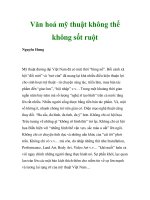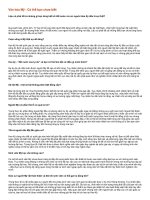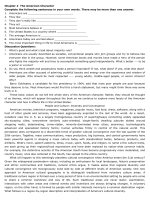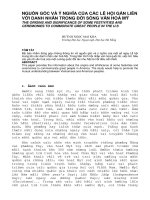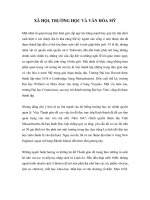VĂN HÓA MỸ
Bạn đang xem bản rút gọn của tài liệu. Xem và tải ngay bản đầy đủ của tài liệu tại đây (115.1 KB, 15 trang )
UNIT 1. SYMBOLS AND HOLIDAYS
A. AMERICAN SYMBOLS
1. THE FLAG OF UNITED STATES
- Before the American Revolution: the British flag
- During the American Revolution: Great Union flag
- The first flag:
+ Who: Betsy Ross
+ Feature: in corner: thirteen white stars in a field of blue; 7 red and 6 white
stripes
- During the war of 1812: fifteen stars and fifteen stripes (7 red and 8 white
stripes)
- Now flag:
+ Thirteen stripes: the thirteen original colonies
+ Fifty stars: fifty states
2. THE NATIONAL ANTHEM OF UNITED STATES
- Who:
+ The lyrics: Francis Scott Key - 35-year-old lawyer and amateur poet
+ Music: John Stafford Smith (30/3/1750 – 21/9/1836)
- When: on September 14, 1814 after witnessing the bombardment of Fort
McHenry by British ships of the Royal Navy iin the War of 1812
- Voted to used: on March 3, 1931
3. THE DECLARATION OF INDEPENDENCE
- Who: Thomas Jefferson
- When:
+ Writed: june to july,1776
+ Vote: 2rd, 7,1776
+ Adopted: on July 4, 1776 in Philadelphia, Pennsylvania
- Content:
+ 1337 words
+ five parts: introduction, preamble, Body (2 section: indictment of King George
III, denunciation of the British people) and conclusion.
- Signatures:
+ 56 signers
+ The first: John Hancock,
+ The youngest signer: Edward Rutledge (age 26)
+ The oldest signer: Benjamin Franklin (age 70)
- Purpose: announce and explain why the separation of 13 North American
British colonies from Great Britain
- 13 Colonies: New Hampshire, Massachusetts, Rhode Island, Connecticut, New
York, New Jersey, Pennsylvania, Delaware, Maryland, Virginia, North Carolina,
South Carolina, Georgia
4. THE LIBERTY BELL
- Name: Previously called the State House Bell or Old State House Bell
- Description:
+ Height: 12 m
+ Weight: 940 kg
+ Material: Copper: 70%; Tin: 20%; other metals: 10%
+ Equivalent to £23,850.1 today
- Designer: Thomas Lester of the London bellfounding firm of Lester and Pack
(known subsequently as the Whitechapel Bell Foundry)
- Location: Independence National Historical Park, in Philadelphia,
Pennsylvania.
- Symbol (Meaning): American independence
- Rung: on July 8,1776
- Cracked (Vỡ):The bell first when rung after its arrival in Philadelphia
- Recast (Đúc lại): Twice by local workmen John Pass and John Stow
- Bicentennial dollar, 1976 issue
- Liberty Bell stamp, issue of 1926
5. THE STATUE OF LIBERTY
- Name: Liberty Enlightening the World
- Designed: French sculptor(Điêu khắc) Frédéric Auguste Bartholdi
- Metal framework (Khung kim loại): Gustave Eiffel
- Inauguration (khánh thành) on October 28, 1886.(Opening) (after 21 years)
(1865-1886)
- Symbol of Freedom of Peoples in the World
- Location: National Park Service, New-York, USA
- Dimensions (kích thước) of the Statue of Liberty:
+ The statue: 46.05m
+ A pedestal (bệ đỡ): 46.94 m
+ Total: 92.99m
+ Weight: 220 tons
- Description:
+ Right hand: hold torch (đuốc)
+ Left hand carries a tabula ansata inscribed JULY IV MDCCLXXVI (July 4,
1776 - the date of the U.S. Declaration of Independence.
+ Crown: (vương miệng)
* Spikes (gai trên vương miệng): 7 spikes – 7 seas; each spike: 8 feet
* 25 window
Chains (xích): Feet of the Statue of Liberty with chains
6. EAGLE IN US FLAG
- Designed:William batton in 1782
- Adopted: 1787
- Symbol:
+ 2 wings are for ambitious (tham vọng) to Unite and the liberty.
+ This olive/laurel (nguyệt quế) represent for glorious victories in the past
+ 13 stripes are for 13 original Colonies.
+ 13 arrows in left feet represented brave spirit of american
+ Jewelry on the head of the eagle represents the prosperity and prosperity of the
United States.
7. THE DONKEY AND THE ELEPHANT
- The Donkey
+ Symbol : Democratic Party (Đảng Dân chủ)
+ First Appearance: 1828 (Democrat Andrew Jackson)
+ Mean: smart and brave
- The Elephant
+ Symbol: Republican party (Đảng Cộng hòa)
+ First Appearance: 1874 (Harper's Weekly)
+ Mean: strong and dignified (Trang nghiêm)
8. UNCLE SAM
- National personification of the U.S
- Named for Samuel Wilson
- Use during the War of 1812
- "E.A – US." Mean "Elbert Anderson [the contractor] and United States but
some one called US: Uncle Sam
- 1860s – 1870s Thomas Nast popularized Uncle Sam (While beard stars and a
tripes suit
- 1917 developed James Flagg (tall top hat, blue Jacket pointing straight head)
B. THANKSGIVING AND INDEPENDENCE DAY
1. THANKSGIVING DAY
- When: on the fourth Thursday of November (Begin: October 1621)
- Originated: a harvest festival (lễ hội thu hoạch)
- Now: Thanksgiving dinner
- Some foods at the first Thanksgiving feast (le hoi): Deer (nai), wild turkey,
corn, beans, pumpkins, and cranberries (việt quất)
- Some traditional Thanksgiving foods today: turkey, dressing, sweet potatoes,
cranberries sauce, pumpkin pie
- The beginning of the fall–winter holiday season
- History: was celebrated by the Pilgrims (Người hành hương)
+ Time: 1620
+ Purpose: wanted make money, religious freedom, hope new life
+ Name’s ship: Mayflower
+ Problems: bad weather, not enough foods, many people sick, 2 people died.
+ The first winter: terrible: very cold, not prepare cold weather, not enough
foods
+ Native American: touch plan corn, how to fish, how to live in a new house
+ The first Thankgiving: A three-day
- Governor William Bradford declared (cong khai)
- President Abraham Lincoln established (thiet lap) Thankgiving as an official
national holiday
2. INDEPENDENCE DAY
- Time: The Fourth of July
- Celebrations: Fireworks, picnics, parades, speeches
- Significance: The day in 1776 that the Declaration of Independence was
adopted by the Continental Congress
3. LEGAL (hop phap) HOLIDAYS IN THE US
- New year’s day: January 1
- Martin Luther King Jr. Day: on the third Monday of January
- Presidents' Day: on the third Monday of February
- Memorial Day: The last Monday in may
- Independence day: july 4
- Labor day: on the first Monday in September
- Columbus day: on the second Monday of October
- Veterans day: November 11th
- Thanksgiving day: on the fourth Thursday of November
- Christmas day: December 25
UNIT 2: FAMOUS PRESIDENTS
1. GEORGE WASHINGTON
- Birth: 22/2/1732 – 14/12/1799
- “The father of our country”
- The first President of US
- 1752 joined Colonial Militia
- 1754 begin his military in French and Indian war
- 1775 lead the continental army into the American revolution
- 1789 became The first President of US to 1797 (retire)
- Political party: independent
2. THOMAS JEFFERSON
- 13/4/1743 – 4/7/1826 Virginia
- 3rd President of American (1801-1809)
- Author Declaration of independence
- Speak: French, Italian, Spanish, Latin, Geek
-Talented: famer, lawyer, scientist, inventor, Philosopher, architect
3. ABRAHAM LINCOLN
- Birth: February 12, 1809 – April 15, 1865 (1809-1865)
- The 16th president of the United States (1861–1865)
- Poor (father and Mother: Thomas Lincoln and Nancy Hanks Lincoln)
- Political party:
+ Whig (before 1854)
+ Republican (1854–1864)
- 1863 Leader of American Civil War: bringing freedom of slaves
Gettysburg famous speech: about government of people
- 1865: assassinated (ám sát)
4. JOHN F. KENNEDY
- Birth: May 29, 1917 – November 22, 1963 (assassinated in Dallas, Texas)
- The 35th president of the US (1/1961-11/1963). The youngest fresident.
- Borned into a wealthy political family in Brookline, Massachusetts
- Graduated from Harvard University in 1940
- Political party: Democratic
- Family was very rich
- Peace corps (tổ chức hòa bình Mỹ) and sent American >60 countries
- “Ask not what your country can do for you
But what you can do for your country”
5. BARACK HUSIEN OBAMA
- Born: 4th August 1961, Honolulu, Hawai
- 44th President of US
- 1st African – American president
- Democratic party
6. DONALD JOHN TRUMP
- Born: 14/9/1946
- Republican party
ESSAY FOURTH SUBJECTS
1. UNITED STATES CONGGRESS
A. NEW WORDS
TT
Words
mean
1
2
3
4
5
6
bicameral
legislature
federal
government
chambers
House of
Representative
s
Senate
lưỡng viện
CQ lập pháp
CP liên bang
T
Words
mean
T
9
requires
đòi hỏi
10 Confederation (N) liên bang.
11
function
chức năng
Viện
Hạ nghị viện
12
13
Republican
Democratic
CH
DC
Thượng nghị
14
approve
phê duyệt
viện
7
direct election
Bầu trực tiếp
15
appointe
bổ nhiệm
7
regardless
bất kể
16
override
vượt qua
8 terms staggered điều khoản so le 17
veto
phủ quyết
B. CONTENT
- Define: The unites states Congress is the bicameral legislature of the federal
government of the United States.
- First Time: The congress was created by the constitution of the United stated
and first meet in 1789
- Current: Congress 116th United States
- Location: Meet in the United States Capitol in Washington D.C
- How part: two chambers:
+ Senate
+ The house representative
- Choose: Through direct election
- How many: 536 voting members and 6 non-voting members (Total: 541)
consist of:
+ 100 members of Senate (each state has 2 senator do not depend on population
or size; each senator is six-year term with term staggered-> so every two years
one – third of the Senator is up for election)
+ 435 members of the house representative (depend on population or size of each
state)
- Qualification: article one of the United States constitution requires:
+ Member of Senate: least 30 years old; have been a citizen of US for 9 years
+ Member of the House representative: least 27 years old; have been a citizen of
USA 7 years
- Party:
+ Usually insist of: the Republican Party and Democratic
+ Rarely with a third party or independent
- Power:
+ Congress appoints supreme court
+ Congress approve legislation (unique create law)
+ The congress refuse to approve Presidential appointment and can override
(overcome) a Presidential veto
2. ELECTORAL COLLEGE
A. NEW WORDS
TT
Words
mean
T
Words
mean
T
1
absolute
đa số tuyệt đối
9 Congressional
đại hội
majority
2
equal
công bằng
10
3
nationwide
Toàn quốc
11
4 Representative
Đại diện
12
5
Democracy
Dân chủ
13
6
Processes
Quy trình
14
7
Candidate
Đại biểu
15
7
Majority
Phần lớn
16
- Reason: The USA system of government is a representative democracy, so
USA citizens don’t vote federal law that through by the electoral college
- Define: a body of electors established by the United States Constitution, which
forms every four years with purpose of electing the president and vice president
of the United States.
- Purpose: electing the President and vice President
- Condition: an absolute majority of at least 270 electoral votes is required to
win the election.(who become the President and vice President when have at
least 270 electoral vote)
- How many:
+ 538 electors
+ The number of each state's electors is equal to the sum of the state's
membership in the Senate and House of Representatives (the numbers of each
state’s elector is is the same the numbers of congress of Senate and
representative)
+ 100 senators and 435 representatives.
+ 3 members of WS D.C (1961 - the Twenty-third Amendment – has the
number’s elector but no more than the least populated state (usually three)
- Qualification:
+ Current a member of party
+ Voter registration (dky)
+ Pledge to vote for the party’s presidential ticket
- Choose electors
+ Appointment state’s legislature
+ Electoral district
+ Proportional vote
+ Congressional district method (dai hoi)
+ Implementation (extension) (bsung)
For example: Floria: governor
California: by state officeholder or candidate
3. THE STATUE OF LIBERTY
A. NEW WORDS
TT
Words
mean
1
2
3
4
5
Sculptor
(skəlptər)
Inauguration
Dimensions
Inscribed
Tablet
nhà điêu khắc
T
T
6
khánh thành
kích thước
ghi lên
bảng
7
11
12
13
Words
mean
Describe
miêu tả
Coinage
tiền đúc
- Name: Liberty Enlightening the World
- Who: a gift from the people of France to the people of the United States
- Symbol: The first the statue liberty is symbol friend, but now it is Symbol of
Freedom of Peoples in the World
- Designed:
+ French sculptor: Frédéric Auguste Bartholdi
+ Metal framework (Khung kim loại): Gustave Eiffel
- Location: National Park Service, on Liberty Island in New York Harbor within
New York City, in the United States.
- Inauguration: on October 28, 1886
- Dimensions: 92.99 m; 220 tones
- Description: The statue is a figure of Libertas, a robed Roman liberty goddess.
+ She holds a torch above her head with her right hand, and in her left hand
carries a tablet inscribed the date of the U.S. Declaration of Independence.
4/7/1776
+ She wears crown with 7 spikes which mean 7 seas.
+ As an American icon, the Statue of Liberty has been depicted on the country's
coinage and stamps
4. THANKSGIVING
A. NEW WORDS
TT
Words
1
mean
T
T
6
Words
mean
Treasured
Trân trọng
Plentiful
sung túc
('treʤə)
2
Union
liên hiệp
Barley /'bɑ:li/
lúa mạch
(combine)
3
Appreciation
sự đánh giá
Harvested
thu hoạch
4
Feast (festival)
bữa tiệc
/fi:st/
5
Sailed
Đi thuyền
- Opening: Thanksgiving is one of America's most treasured holidays and
traditions. It means family union, helping each other and sharing with each other
and thanks for all the things we have in life.
- Time: on the fourth Thursday of November
- History:
+ The American Thanksgiving holiday began as a feast in the early days of the
American colonies almost 400 years ago.
+ In 1620, a boat name Mayflower filled with more than 100 people sailed
across the Atlantic Ocean from England to settle in the New World. They hope
wanted make money, religious freedom, hope new life. Problems: bad weather,
not enough foods, many people sick, 2 people died.
+ The pilgrims settled in what is now the state of Massachusetts, and their first
winter in the New World was difficult. They fell terrible: very cold, not prepare
cold weather, not enough foods because they arrived too late to grow any crops
(bat ky loai cay nao)
+ The following spring, Native American: touch plan corn, how to fish, how to
live in a new house
+ In the autumn of 1621, plentiful crops of corn, barley, beans and pumpkins
were harvested.
+ The colonists had much to be thankful for, so a feast was planned. They
invited the local Indian. In following years, many of the original colonists
celebrated the autumn harvest with a feast of thanks
+ After the United States became an independent country, Congress
recommended one yearly day of thanksgiving for the whole nation to celebrate.
+ George Washington suggested the date November 26 as Thanksgiving Day
+ and then in 1863, at the end of the long civil war, Abraham Lincoln asked all
Americans to set aside the last Thursday in November
UNIT 3.
MODULE 3A. THE GEOGRAPHY OF THE UNITED STATES
- Area: the fourth largest country in the world in the land area.
- North: Canada with 13 states on the border of Canada: Maine; New
Hampshire; Vermont; New York; Pennsylvania (border on Lake Erie); Ohio
(border on Lake Erie); Michigan; Minnesota; North Dakota; Montana; Idaho;
Washington; Alaska
- South: Mexico with four states: California, Arizona, New Mexico, Texas
- Between two ocean:
+ The East: Atlantic Ocean
+ The West: Pacific Ocean
- Fie Major territories: American Samoa, Guam, the Northern Mariana Islands,
Puerto Rico and the U.S. Virgin Islands
- Mountain, deserts, lakes and river
+ River:
* Longest river Mississippi flows south into the Gulf of Mexico; (the longest
river in US
* Missouri and Ohio rivers flow into Mississippi
* Rivers to the east of the divide flow east
* Rivers to the west flow in to Pacific Ocean
+ Mountain:
* Two main mountain ranges run North and South
-> The Appalachian Mountain: eastern
-> The Rocky Mountain: west
(Between: the Great Plains - vùng đồng bằng lớn)
-> Another mountain: The Sierra Neveda and the Cascade Range: Chain West of
the Rocky
+ Lake:
* Great lakes on the northern: (5) Superior, Michigan Huron, Erie and Ontario
* The Great salt lake: the western part in US (Eastern The Sierra Nevada and
Cascade mountains
+ Desert:
* The Mojave, The Gila and The Painted Desert are in Southwestern
* The Mojave Desert is west of Colorado river
UNIT 5. THE US CONSTITUTION
MODULE 5A: OVERVIEW OF THE CONSTITUTION
- The Constitution of the United States is the supreme law of the United States
of America
- The Constitution of the United States is the oldest, shortest
- Time 1787, came into force in 1789
- Three main principles (Ba nguyên tắc chính):
+ The separation of power of the three branches of government
+ Government of, for and by the people
+ Basic human right (individual freedom, equality, and justice (tự do cá nhân,
bình đẳng và công lý)
- Three parts:
+ The preamble (MD)
+ The Document contains 7 articles
+ Amended 27 times (including one amendment that repealed a previous one)
(26 amendment guarantee individual right and freedom and establish other basic
principles of government)
- Article one created: legislative Branch of Government
+ Congress make laws of the nation
+ The two house congress: Senate and the house Representative
+ The people of each state elect 2 Senators
+The Popolation of each state determines the number of Representative
- Article two created: Executive Branch of Government
+ The electoral college elect President
+ The president is the chief executive of the nation and commander in chief of
the armed forces
+ The president has certain power, such as to enforce laws
+ The president may initiate the law-making process
- Article three: Judicial Branch of Government
+ The Supreme Court is the highest court in the land…
- Article four: defined the relationship among states and relationship to the
federal Government
- Article five: way amend (change) constitution
- Article six: declared (cong khai) the constitution the supreme law of the land
- Article seven declared that nine states must ratify the constitution for it to
become law
- After the Revolutionary war, the Article of confederation (1871) was the basic
of the new American government.
- The result of the Constitution Convention of 1787 was the US constitution
- One of the main principle of the constitution is the separation of powers of the
three branches of government
- Another principle is government of, for and by the people
- The third principle is basic human rights: individual freedom, equality and
justice
- The three parts of the constitution are the preamble, the seven article of
document, the twenty – six amendments (sua doi)
MODULE 5B: BASIC RIGHT AND FREEDOM
UNIT 6: FEDERAL GOVERNMENT OF THE UNITED STATES
MODULE A. OVERVIEW OF U.S.GOVERNMENT
A. THE AMERICAN SYSTEM OF GOVERNMENT
- The US is a democratic republic (a representative democracy).
- The national government is a government of all the people and their
representative (elected officials)
- The federal government of the United States because the nation is a federation,
or association of states
- The U.S constitution gave the federal government only limited powers, the
power started in the constitution.
- All other powers belong ti the individual states.
- The founding fathers established three branches of government:
+ Legislative: makes all laws, declares war, regulates interstate and foreign
commerce and controls taxing and spending policies.
+ Executive: consists of the President, his or her advisors and various
departments and agencies
+ Judicial: the U.S. Supreme Court and the Federal Judicial Center
1. Legislative
- is called Congress (538 members)
- Consist of: House of Representatives and the Senate.
+ The House of Representatives
* Consists of 435 voting members, each of whom represents a congressional
district, is based on each state's population
* Serve a two-year term
* Each state receives a minimum of one representative in the House.
* Qualities: at least 25 years of age, must have been a U.S. citizen for at least
seven years, and must live in the state that they represent.
+ Senate
* Made up of two senators from each state
* There are currently 100 senators (2 from each of the 50 states)
* Serve six-year terms
* Qualities: least 30 years old; have been a citizen of US for 9 years
- The responsibility of congress: propose and pass laws, refuse to approve
President appointments and override a Presidential veto.
2. Executive branch
- The president and vice president, the Cabinet, (15) thirteen Departments
(chosen by the president and approved with the "advice and consent" of the U.S.
Senate) and independent agencies
- Duty: enforce (thuc thi) laws
+ The president has the power to veto any bill law of congress; appoints all
supreme court Justince
3. Judicial branch
- Consists of Supreme Court and other federal courts (11 Circuit Courts of
appeals and 94 District courts).
- Duties:
+This branch explain and interprets law and make decisions in lawsuits.
+ Apply laws to individual case
+ Decide if law or acts violate the constitution
B. POLITICAL PARTIES
- The US constitution doesn’t talk about political parties.
- Early political parties: Federalist and the Whigs
- 1854: 2 major parties: Democrats and Republican
- Thomas Jefferson leader Democratic
- “Liberal” (cntu do) politician usually favor reform and progress
- Conservative (Dang bao thu) politician usually oppose change
- Both Liberal and Conservative mebers belong to the two major political
partiesand their ideas often change with the times and issues
1. Democratic Party
- The Democratic Party is one of two major political parties in the U.S.
- Founded as the Democratic-Republican Party in 1792 by Thomas Jefferson and
James Madison
- 1829 Andrew Jackson became the first president The Democratic Party
- more liberal than the The Republican Party
- since 1912 The Democratic Party has positioned itself as the liberal party on
domestic issues.
- it is the oldest extant voter-based political party in the world
- Obama was the 15th Democrat to hold the office
- want to establish social programs for people: poor, unemployed, elderly
- believe: equal right for women, minorities (dân tộc thiểu số ), oppose nuclear
weapon, too much military spending
- Symbol:the donkey
2. Republican Party
- The Republican Party is one of the two major contemporary political parties in
the United States of America.
- younger than the Democratic Party although called: G.O.P (the grand old
party)
- Republican oppose slavery
- Republican Party supports an American conservative platform
- Abraham Lincoln: the first Republican candidate to become president
- after Civil war, Republican interested in: farm, land, business issues
- Republican vote more conservative than Democratic
- support (ung ho) big business, not control the live of citizens
- oppose spending for social program but support military spending
- Symbol: elephant
S
time
Old
Democratic Party
1790
the oldest extant voter-based
political party in the world
First
first
presiden
t
1829 Andrew Jackson became
the
Republican Party
1854
G.O.P (the grand old party) but
younger than the Democratic
Party
Abraham Lincoln
Want
establish social programs for
people: poor, unemployed,
elderly
Supports - more liberal
- equal right for women,
minorities (dân tộc thiểu số ),
oppose
Symbol
nuclear weapon
too much military spending
The donkey
Obama was the 15th Democrat
to hold the office
The house of representative
interested in: farm, land,
business issues
- more conservative
- big business, not control the
live of citizens
- military spending
- oppose slavery
- spending for social program
Elephant
the
Senate.
majority
MODULE 6B: THE LEGISLATIVE BRANCH
- The legislative branch in the Congress which is made up of two chambers: The
US Senate and The US house of representatives.
- Congress write, debates, passes bills (proposals for new laws)
- Bills that are passed by both chambers of Congress and then signed by the
president become law
The US Senate
Numbers of Members
Numbers of Members
per state
Length of term
Age Requirement
Citizenship
requirement
Dates of regular
session
100
2
6 years
At least 30
At least 9 years as a US
citizen
3/1
The US house of
representatives.
435
Determined by state
population
2 years
At least 25
At least 7 years as a US
citizen
3/1 (January 3 to
adjournment)
MODULE 6C: THE EXECUTIVE BRANCH
- Consist of: President, Vice president, Cabinet, executive departments, and
agencies
MODULE 6D: JUDICIAL BRANCH
- The Supreme Court of the United States
- Other federal courts




